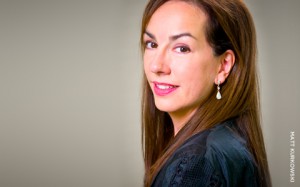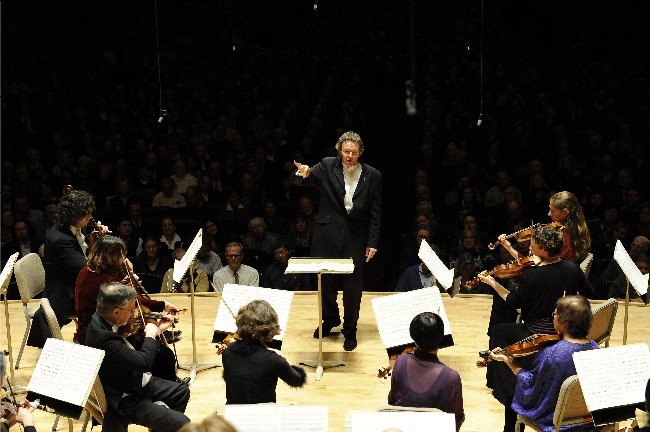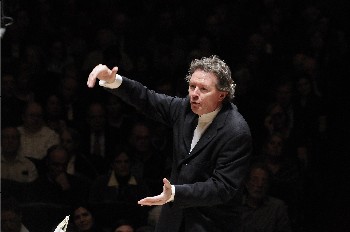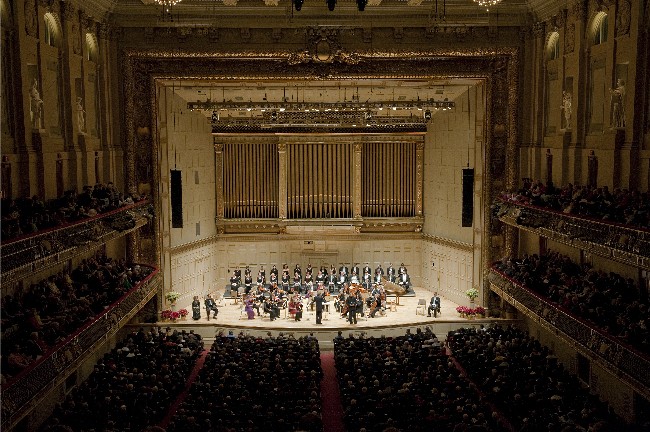Classical Music Commentary: The Perilous Life of the Handel & Haydn Society?
The greatest obstacle H&H faces in building new audiences, though, is far more insidious than too many period ensembles in town: it has to do with time.
By Jonathan Blumhofer
My periodic survey of the financial and artistic health of Boston orchestras now turns to the city’s Handel and Haydn Society (H&H), the nation’s oldest performing arts ensemble. Founded in 1815 “to promote the love of good music and a better performance of it,” H&H has regularly presented local, national, and world premieres (including the Boston premiere of Mendelssohn’s Elijah in 1848, the first American performances of Verdi’s Requiem in 1878, and the world premiere of Randall Thompson’s Passion According to St. Luke in 1965); performed at major events; and collaborated with leading cultural, political, and musical figures over its first nearly two centuries.
In fact, many of the legendary names one associates with New England pepper the Society’s roster from time to time: Daniel Webster, Lowell Mason, Edward Everett, Charles Perkins, Ralph Waldo Emerson, Julia Ward Howe, and Henry Lee Higginson were all either Society members, presidents, or orators in concerts. According to legend, the Society’s reputation as the city’s preeminent chorus prompted Higginson to found the neighboring ensemble with which H&H now shares a home: the Boston Symphony Orchestra (“This is a very good chorus. All it needs is an orchestra,” he reportedly said).
With such an impressive legacy, it might seem easy for H&H to rest on its laurels. A quick glance at its upcoming performances and activities in this and past seasons, though, reveals nothing of the sort. If anything, H&H is more active than ever and on an increasing number of fronts, including—crucially—music education. While in times of crisis many cultural institutions have been forced to pull back, H&H is moving forward, conscious of its limitations but determined and excited to carry out its mission all the same. This is in line with the vision of its leadership, says executive director and CEO Marie-Hélène Bernard: H&H is proactively “staying vibrant by not being afraid of experiencing new things.”
In terms of finances, H&H is in a healthy position. Operating on a budget of just under $3.2 million, H&H turned a surplus of nearly $10,000 in FY 2011 and is poised to do similarly well this year. The primary reason for this is simple: giving is up. In FY 2011, H&H raised $1.5 million (up 12% from FY 2010), which included increases in foundational giving (up an astonishing 85%), institutional giving (up 40%), and a rise in government funding (up just over 10% than anticipated). The challenge to maintain such giving levels—let alone manage modest increases—remains, but with prudent management and its present focus on stewardship and cultivation, H&H appears to be in a relatively stable position.

Marie-Hélène Bernard, Executive Director and CEO of the Handel and Haydn Society. Handel & Haydn Society is “not afraid of experiencing new things.”
A study of the H&H annual report reveals a number of promising trends in its audience: in the 2010-2011 season, H&H sold nearly 30,000 tickets, of which 15% were to first-time attenders; a survey from spring 2011 showed that 40% of H&H’s audience was under the age of 54 and a very healthy 19% under the age of 34. Some of H&H’s success in developing a younger audience can be attributed to its embrace of technology: through its website and various social media forums, the Society has been able to target specific demographics and communicate via a monthly e-newsletter to subscribers and potential audiences.
The challenge of creating and maintaining an audience and donor base in a city with multiple ensembles that specialize in Baroque and early Classical music is one of which H&H is well aware. This difficulty is partially eased by the diversity of repertoire performed by H&H, Boston Baroque, and others. “Actually, we present very different products and programs that reach out to different audiences,” Ms. Bernard notes. Even though some crossover may occasionally occur, this is not seen as a threat: “It’s great for Boston [audiences] to hear great groups, and we don’t see it as competition if we can continue to provide quality performances.”
Quality performances are, of course, at the heart of what H&H does. Now in his fourth season as artistic director, Harry Christophers has settled comfortably into his role as the public face of H&H and is putting his stamp on the Society’s musical offerings. Last season’s “Classical Salon” concert will be followed this coming season with the first Symphony Hall performance of Handel’s Jephtha since the Johnson administration (Andrew’s, that is—in 1867) and Purcell’s The Indian Queen. “Harry makes you hear works you think you know for the very first time,” Ms. Bernard enthuses. “The drama his performances elicit is very impressive.” Impressive enough, indeed, that the Society recently extended Mr. Christophers’s contract through the 2016 season; two examples of his work with H&H can be heard in recordings of Mozart’s Mass in C minor and Requiem made in 2010 and 2011, respectively, on the Coro label.
The greatest obstacle H&H faces in building new audiences, though, is far more insidious than too many period ensembles in town: it has to do with time. “People today are too busy,” Ms. Bernard observes, “they need to take time to slow down and enjoy concerts and other offerings in the arts. The fact is, we need to reach out to our community and meet people where they are.” To this end, H&H has been considering ways to engage potential new audiences, and ideas include providing free lunchtime concerts at various venues across the city to further engaging Boston’s business community in the Society’s mission. “If the business community supports the arts,” Ms. Bernard states, it becomes easier “for employees to get involved in the arts.”
As noted earlier, one of H&H’s remarkable successes in its audience-building efforts has involved growing its appeal to concertgoers under the age of 50. H2, the Society’s subscription geared towards young professionals, provides post-concert activities (as well as ticket and merchandise discounts) that encourages members to mingle with H&H musicians and guests over drinks. Like the Boston Symphony’s somewhat equivalent UnderScore series that makes an effort to lessen the formality that surrounds many classical music events, H&H’s approach seems to be working rather well: the 18–44 age bracket makes up 31% of H&H audience. There is still room to grow, however: “We’re working to put more content on our website,” Ms. Bernard says, “especially more information for audience members to be able to explore the music after-the-fact—like recommended recordings, books about composers and specific pieces, and so forth.”
H&H’s desire to be a local educational and informational resource is unsurprising, especially considering the fact that the institution was once headed by Lowell Mason, the father of American music education. Appropriately, H&H remains firmly committed to teaching music to all ages. At the college level, since 2008, H&H has maintained a choral coaching affiliation with MIT and also has ties with music programs at Tufts and Harvard. Perhaps most notable is the conducting program H&H and neighboring New England Conservatory have developed: each year, three student conductors are assigned to major programs throughout the season, for which they engage in score study, attend rehearsals, and interact with the conductor of that program. The conducting program goes hand-in-hand with what Ms. Bernard describes as H&H’s mission to “become a resource for area colleges.”
H&H’s programs to serve children and youth, though, compose the biggest part of its educational mission. There are several initiatives that accomplish this goal, the most prominent of which is the Vocal Apprenticeship Program (VAP), which sponsors four choirs: the Singers (geared towards young students in grades 3–5), the Youth Chorus (for middle school students), the Young Men’s Chorus (for males in grades 8–12), and the Young Women’s Chorus (grades 9–12). Led by some of the leading music educators in the area, the choruses perform a wide range of repertoire (encompassing folksongs, spirituals, classical music, popular music—and more in between) in various venues throughout Boston and Cambridge, as well as at Society events, and offer many of their members the first opportunities they have had to study and perform music.

Handel & Haydn Society’s programs to serve children and youth, though, compose the biggest part of its educational mission. Photo: Stu Rosner
Along with the VAP, the Society’s Vocal Quartet presents original, interactive presentations at local schools that are designed to teach music history. H&H also sponsors annual Collaborative Youth Concerts that bring together singers from different high schools and districts in performances with H&H musicians. The repertoire is drawn from H&H programming during a given season (last year’s piece was Handel’s Israel in Egypt), and the concerts are then held at the students’ schools as a gift to their peers, families, and communities.
Also part of the H&H mission, though understandably not at the forefront, is a focus on commissioning and premiering new works. Of late, most of the new music written for H&H has been composed for the VAP program: John Finney, Beth Denish, and William Hawley have all written pieces premiered by the VAP choirs in the last decade. “It’s easier,” Ms. Bernard comments, “to give life to a piece that can be performed many times and travel.” Even so, a glance at the Society’s history shows, in addition to the Thompson St. Luke Passion, performances of commissions from Daniel Pinkham, Dan Welcher, and John Tavener, in addition to non-commissioned, local premieres of works by Arthur Honegger, Dominick Argento, and Silvio Amato in just the last 45 years—not bad, at all, for a period ensemble that specializes in music written before 1840. For the Society’s bicentennial in 2015, the composer Gabriella Lena Frank has been commissioned to write a work for chorus and chamber ensemble drawn from the H&H roster.
So, while the Society’s first two centuries have been marked by a number of musical highs and, at present, things seem to be going well, what is there that we can look forward during H&H’s bicentennial in 2015? As befitting the occasion, quite a bit: among other things (and in addition to performances of Messiah will that bracket the “official” celebration), the Society will present free concerts for the city of Boston; it will participate in the Chorus American conference, to be held in Boston in June 2015; archival materials will be on display throughout the year at the Boston Public Library; and an app that will provide a walking guide to various locales important to H&H history is in the works. “What has happened in this city over two hundred years is reflected—in many ways—in this organization,” Ms. Bernard says. “What we want, above all, is for Bostonians to feel that H&H is their musical organization, because it is.”
Jonathan Blumhofer is a composer and violist who has been active in the greater Boston area since 2004. His music has received numerous awards and been performed by various ensembles, including the American Composers Orchestra, Kiev Philharmonic, Camerata Chicago, Xanthos Ensemble, and Juventas New Music Group. Since receiving his doctorate from Boston University in 2010, Jon has taught at Clark University, Worcester Polytechnic Institute, and online for the University of Phoenix, in addition to writing music criticism for the Worcester Telegram & Gazette.
Tagged: Handel & Haydn Society, Handel and Haydn Society, Harry Christophers


